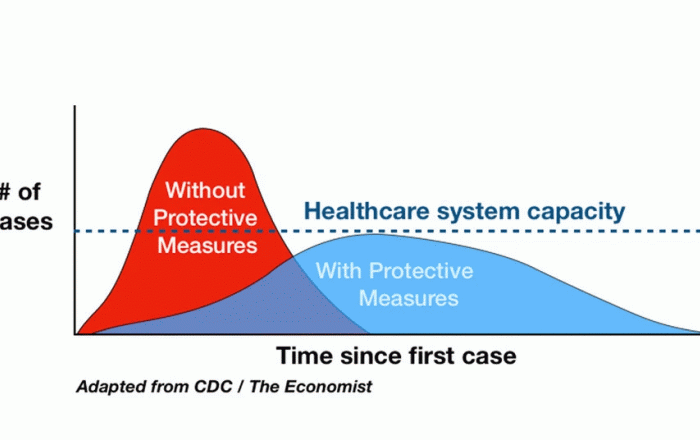Leaked documents reveal coronavirus could kill half a million Americans

With Coronavirus casualties continue to rise around the world, many are already comparing the virus to the epidemic of 1918. Just as in 1918, we currently lack a vaccine or wonder drugs to cure the disease. People are panicking and stocking up on basic necessities. However preparation not panic, is key. Infections and casualties depend on our preparation and containment of the virus. As part of preparation and response for the virus, Dr. James Lawler, a professor at the University of Nebraska Medical Center, is advising hospitals to prepare for up 96 million coronavirus infections and 500,000 potential deaths as a worst-case scenario for the potential extent of the outbreak, leaked documents show.
The leaked documents, obtained by Business Insider, come from a presentation which was part of a webinar hosted by the American Hospital Association (AHA). As part of the presentation, Dr James Lawler shared a series of slides with attendees about what his “best guess” was when estimating how the outbreak could impact hospitals and health officials. His webinar, titled “What healthcare leaders need to know: Preparing for the COVID-19“, was presented on 26 February.
As part of his presentation, Dr James Lawler estimated 96 million could become infected, and of those people 480,000 could die from the coronavirus based on how the virus might spread. Below are his best estimates for how much the coronavirus will spread in the United States:
- 96 million total cases
- 4.8 million hospitalizations, and 1.9 ICU admissions
- 480,000 deaths
Dr. Lawler’s research assumes a doubling time of seven-to-ten days based on a Ro of 2.5. It assumes 5% of cases will require hospitalization and 1-2% will require ICO care. It assumes a case fatality rate of only 0.54% – significantly lower than the WHO’s projection of 3.4%.
The leaked documents also showed the expert anticipated the virus would hit the elderly population the hardest. For example, elderly and pople aged 80 and over have a 14 per cent chance of dying if they have the infection, Dr Lawler estimates.
Those aged 70 to 79 and 60 to 69 have an estimated mortality rate of 8 per cent and 3.6 percent if they contract the virus.Medical conditions can also influence someone’s risk. Dr Lawler estimates those with heart conditions would have a one and 10 chance of dying from the disease.
For people without any pre-existing medical conditions, there is only a one in 100 chance they could die.Dr Lawler reported his estimates to encourage hospitals to prepare for high numbers so each facility can limit those who die.
Below are the slides presented in the webinar.
The presentation featured “national experts from several health care organizations,” the AHA said on its website. Its focus: getting healthcare leaders up to speed on how to prepare for the novel coronavirus, which causes the disease known as COVID-19
 AHA webinar
AHA webinarSource: AHA
As part of the presentation, the experts laid out facts about the virus, how hospitals can prepare, and details on what prevention tactics might be key to combating its spread.
 AHA webinar
AHA webinarIn attendance were experts from Massachusetts General Hospital, the University of Nebraska Medical Center…
 AHA webinar
AHA webinar… Emory University Hospital and HCA Healthcare.
 AHA webinar
AHA webinarSome are affiliated with the National Ebola Training and Education Center, an organization created in the wake of the Ebola outbreak in 2015 to help hospitals and public health organizations safely manage patients with suspected and confirmed cases of Ebola and other pathogens.
 AHA webinar
AHA webinarThe presentation started with an overview of the novel coronavirus as of the end of February.

At that point, there were 81,191 total confirmed cases around the globe. Now, more than 100,000 people have been infected.
 AHA webinar
AHA webinarSource:Business Insider
The presentation laid out the distinction between quarantine and isolation, which are both being used to quell the spread of infection.
 AHA webinar
AHA webinarIt also pointed to recent literature published on the outbreak showing the number of cases in China per day.
 AHA webinar
AHA webinarSource: JAMA
Cumulatively, hospitalization rates were going up, especially in Wuhan in the days since the outbreak began.
 AHA webinar
AHA webinarThe presentation also highlighted the different factors that contribute to mortality with the novel coronavirus. The death rate among those 80 and up is significantly higher than other age brackets.
 AHA webinar
AHA webinarRead more: What to know about the coronavirus outbreak in 9 charts and maps
In a part of the presentation conducted by Dr. James Lawler, a professor at the University of Nebraska Medical Center Department of Internal Medicine, he said that he’s estimating that the US could have 96 million cases, of which 4.8 million could result in hospital admissions. The slide does not give a particular time frame.
 AHA webinar
AHA webinar“Those estimates were from Dr. Lawler’s presentation and represent his interpretation of the data available. It’s possible that forecast will change as more information becomes available,” a spokesman for Nebraska Medicine told Business Insider in an email.
In particular, the slide points out that hospitals should prepare for an impact to the system that’s 10 times a severe flu season.
Lawler isn’t alone in anticipating widespread infections. Marc Lipsitch an epidemiology professor at Harvard University told The Atlantic he predicts anywhere from 40-70% of people globally will be infected with the novel coronavirus within the next year.
Other experts also presented.
 AHA webinar
AHA webinarThe presentation also explored how hospitals can be ready, as HCA’s chief of preparedness and emergency operations Mike Wargo presented.
 AHA webinar
AHA webinarThat includes having the team in place to handle an emergency, from clinical teams to teams monitoring the situation, to those making sure there aren’t issues getting supplies.
 AHA webinar
AHA webinarThe bulk of the presentation focused on laying out best ways to “identify, isolate” and “inform.”
 AHA webinar
AHA webinarHere’s a look at the clinical criteria used to evaluate potential coronavirus patients.
 AHA webinar
AHA webinarSource: CDC
As more patients around the US start presenting with symptoms, having a safe way to identify them will be key.
 AHA webinar
AHA webinarThe presenters highlighted the different ways patients might come to the hospital, through the emergency department, by ambulance, and possibly in a number of different conditions.
 AHA webinar
AHA webinarThe presenters pointed to putting up signage that could help patients identify themselves as someone who could potentially have the novel coronavirus and might need a face mask.
 AHA webinar
AHA webinarHere’s an example of a screening protocol from Nebraska Medicine based on guidelines around travel as an indicator for the disease.
 AHA webinar
AHA webinarIsolating patients who have a confirmed infection will be key for health systems as well.
 AHA webinar
AHA webinarThe presenters recommended putting patients in masks who present with respiratory illness symptoms and following good hand hygiene for both healthcare providers and the patients.
 AHA webinar
AHA webinarThe presenters pointed to guidelines from the Centers for Disease Control and Prevention for infection control.
 AHA webinar
AHA webinarFinally, the experts presented on what hospitals should do to keep their communities informed: both within the hospitals and outside.
 AHA webinar
AHA webinarThat includes making sure teams are entirely linked up in case cases arise.
 AHA webinar
AHA webinarThat includes contacting people outside the organization, including local and state public health organizations.
 AHA webinar
AHA webinarThe presentation also laid out what protective equipment is needed for COVID-19.
 AHA webinar
AHA webinarThat includes a face shield, N95 respirator mask, isolation gown and a pair of gloves.
 AHA webinar
AHA webinarThis part of the presentation deals with the importance of communicating about the outbreak within hospitals.
 AHA webinar
AHA webinarHospitals need to prepare to communicate with their workers and with the media.
 AHA webinar
AHA webinarThis slide has some best practices developed in Nebraska.
 AHA webinar
AHA webinarThe presentation also included a discussion of supply chain issues for hospitals.
 AHA webinar
AHA webinarIt ends with resources for health systems.
 AHA webinar
AHA webinarThe webinar also provided links through which AHA’s members could continue reading for more information.
 AHA webinar
AHA webinar



